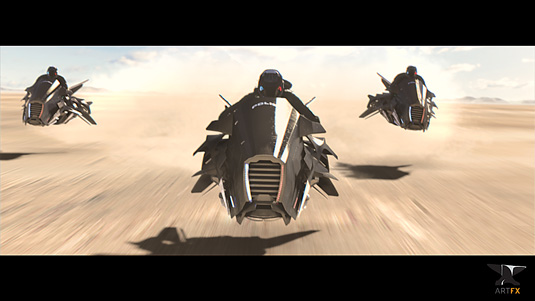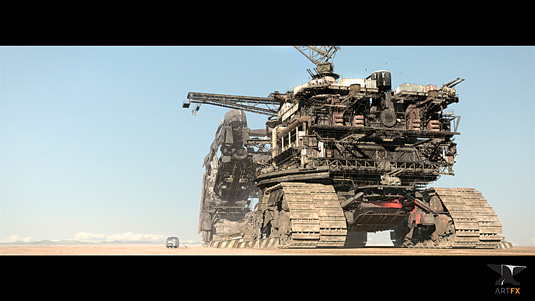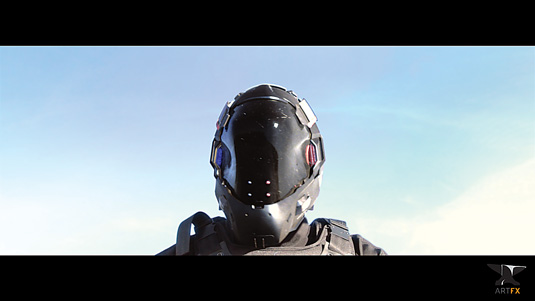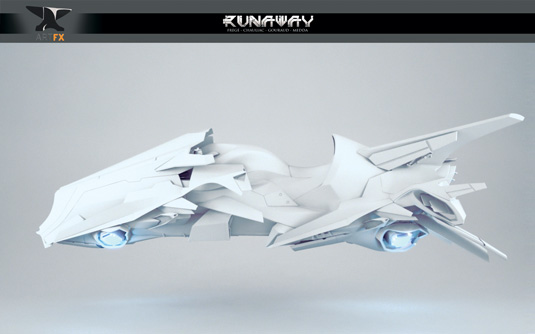You won't believe this Star Wars-inspired film is a graduation project
We talk to the directors of Runaway about the film's influences and how to successfully blend live action and CG.
The production in Runaway is so highly polished you'd be forgiven for thinking that it's a teaser for the next Hollywood blockbuster. But in fact the film is the hard work of ArtFX students, Romain Chauliac, Ludovic Fregé, Yoann Gouraud and Quentin Medda (with a little extra help from five fellow students) and was produced as their graduation project. With matchmoving, camera mapping, texture projections and CG integrations, the short presented many challenges to the four young talents.
The story of Runaway was heavily influenced by the character of Fred (the gas station attendant) in the 2006 horror-thriller The Hills Have Eyes, as Medda explains: "He's a bit of a crook, trying to take advantage of every situation as long as it rewards him with money. Stylistically, the short is all about contrast. So we have this kind of Mad Max, low-tech vehicle opposing the latest technology in speed and levitating vehicles of the cops."
For the look and feel, the team drew inspiration from the Star Wars and Star Trek franchises, and researched the land-speed vehicles from the Bonneville Salt Flats races in Utah.

Conceptual challenges
The directors spent much of their production time perfecting the concepts. "Our main goal was to create various and really originals concepts," says Chauliac. "We spent a lot of time on each one to make them more accurate and realistic. I was mainly involved in the modelling and concepts. On the Salt-Eater, the most difficult part wasn't technical - despite it not being a typical model to deal with - it was the concept stage that was particularly challenging."
Our main goal was to create various and really originals concepts
To create the Salt-Eater they tried a lot of different quick shapes in 3D, with some simple low-poly elements. "Like Lego bricks, we could easily try different possibilities with a lot of tyres, tanks and so on," says Chauliac. "Then, once we agreed on the concept, I blocked it in with the right scale and placed it on our 3D previz scene. That way we could build our plans and place our cameras precisely. It was key to modelling a big vehicle in a short time."

Chauliac admitted that they did make a few mistakes that could have saved them some time. For example, the Speeder (the police vehicle), which isn’t seen clearly in the short, was fully realised in terms of design and animation.
Medda was in charge of texturing and matte painting on Runaway, which was a tough job as the assets needed to stand up to scrutiny. "I think the most difficult thing was the huge amount of assets to texture in time, their huge scale and the fact that most of them would be seen close up," he says.
Yoann was in charge of the lighting and rendering. "One of the most difficult things was probably to reproduce a great variety of materials. The massive vehicle has a lot of rough materials, whereas the materials are much shinier in the case of the helmets and Speeders," says Medda.
The rules of integration
The integration of the Salt-Eater vehicle was another issue: they had to find a way to make it connect with the ground. "We used a shadow pass and ambient occlusion to help us make the vehicle belong to the environment," says Fregé. "It was also tricky to show the scale of it. Most of the time, we used the Z-Depth pass to mimic atmospheric attenuation on the vehicle, as well as adding details like vultures flying above it so that people would have a real-world reference."
Fregé was the project lead and was responsible for the digital compositing. "Integrating the police officer's helmet was difficult because the helmet had to rest both in front of and behind the actor's head," he says. "So I had to split the CG render using depth information."
To do this, Ludovic parented a sphere in the middle of the helmet in Maya, and rendered it and tracked it in Nuke. "With some expressions, I retrieved the depth data. With a Zslice I could then split the render and integrate the live-action footage between the two parts."

New tech choices
Historically, ArtFX productions have used mental ray to render, but the team was given the choice to try out new software. "Regarding the rendering, we were given the amazing opportunity to use Arnold, which is quite uncommon for a school. V-Ray was also considered at the beginning of the project," says Gouraud. The team chose to use Arnold and Mari to gain experience of using a new software in production, and also because Arnold is "quite good with outdoor scenes and soft reflections".
Gouraud also did a bit of shader coding for Arnold, most notably a colour correction tool: "From just a diffuse map, I could make several variations to use as specular colour, specular roughness or bump," he says. "It has its limit, but it helped reduce the amount of textures on the Salt-Eater and lots of other assets."
Like-wise, Mari was chosen for the texturing because of its flexibility with dealing with large maps and layers. "Using Mari for the texturing saved time and we were able to gain considerable precision by painting directly on the 3D model, or in the UV in the same software, and deal with a huge amount of 8k maps at the same time," says Medda.

The students had trained using Photoshop and Mudbox, but Mari proved to be a powerful tool: "Shaders preview was a great thing to have," explains Gouraud. "Nuke was used for the compositing, especially for the Salt-Eater. It's also helpful to make lighting in real time. One of my favourite modelling tools, which saved me on this project, was the plug-in, Nex. It's really good that Maya includes it by default."
In producing Runaway, the artists gained valuable experiences, learning how to deal with the entire pipeline, from scheduling and pre-production to shooting and post-production.
Want to know more? Take a look at this cool making of video:
Words: Kulsoom Middleton
This article originally appeared in 3D World magazine issue 176.
Like this? Read these!
- The best 3D movies to look forward to in 2014
- Click here for brilliant 3D artists to follow on Behance
- Top free 3D models

Thank you for reading 5 articles this month* Join now for unlimited access
Enjoy your first month for just £1 / $1 / €1
*Read 5 free articles per month without a subscription

Join now for unlimited access
Try first month for just £1 / $1 / €1
Get the Creative Bloq Newsletter
Daily design news, reviews, how-tos and more, as picked by the editors.
The Creative Bloq team is made up of a group of design fans, and has changed and evolved since Creative Bloq began back in 2012. The current website team consists of eight full-time members of staff: Editor Georgia Coggan, Deputy Editor Rosie Hilder, Ecommerce Editor Beren Neale, Senior News Editor Daniel Piper, Editor, Digital Art and 3D Ian Dean, Tech Reviews Editor Erlingur Einarsson, Ecommerce Writer Beth Nicholls and Staff Writer Natalie Fear, as well as a roster of freelancers from around the world. The ImagineFX magazine team also pitch in, ensuring that content from leading digital art publication ImagineFX is represented on Creative Bloq.
